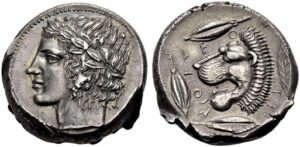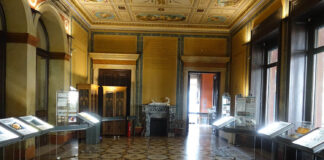
One of the highlights of the forthcoming auction sale 49 of Münzen & Medaillen GmbH, Weil am Rhein, is a silver drachma minted in Naxos on Sicily between 530 and 490 B.C. The particularly well-preserved coin features the bearded profile head of the wine god Dionysos on the obverse, and was described by Münzen & Medaillen AG Basel as „ce chef d’oeuvre de l’art grec archaïque“, when they auctioned the coin in November 1977. High praise indeed, given that the catalogue was most likely written by Herbert Cahn, who had also compiled the most complete study of the coins of Naxos (Basel 1944). In the last decades the coin has formed part of a small but discerning collection of ancient Greek coins assembled by a female collector.
This drachma is one of the earliest coins minted by Sicilian Naxos, which had been founded by colonists from Chalcis in Euboia on a rocky headland (modern Capo Schisò) on the Eastern side of Sicily some 250 years previously, in 735/4 B.C. We know this from fragments of the otherwise lost historian, Ephorus. The first wave of colonists probably included enough inhabitants of the “old” Naxos, the island in the Cyclades, that they decided to name their new home after the old one, just as settlers from Europe later did in the USA. At the time the coin was minted at the start of the 5th Century, Naxos was a flourishing city, the oldest colony in Sicily. Interestingly, they were still minting coins according to the old Chalcidian weight standard which they had brought with them. Behind the city, which was built on a peninsula by the Ionian sea, the slopes of Mount Aetna were ideal for the cultivation of vines, which grew well in the fertile volcanic soil. The importance of wine in the economic (and social) life of the inhabitants undoubtably played a role in the choice of the coin’s reverse motif, the stylised bunch of grapes – and presumably also in the choice of the head of Dionysos on the obverse.

The god Dionysos was associated with the other Naxos, the Cycladic island in the Aegean sea. According to the mythical tales he took a voyage there with a group of Tyrrhenian (Etruscan) pirates, but when after a short while he realised that they had no intention of bringing him to his destination but instead planned to sell him into slavery, he transformed the mast and oars of the ship into serpents and filled the hull with ivy, so that the sailors, seized with terror or madness (or both), leapt into the sea and were transformed into dolphins. Most famously, Dionysos discovered Ariadne sleeping on the beach on the “other” Naxos, where she had been abandoned by Theseus, and made her his bride. Their son Oinopion, „the wine-faced“, or „wine-drinker“, is said in some accounts to have brought wine to Chios. The choice of the god Dionysos for the coins of Sicilian Naxos probably mirrored the traditions of the settlers from the island of Naxos, since elsewhere in Sicily Apollo played a greater role – on the coins of Leontinoi, for example (lot 62), where there is a fine portrait head of the youthful God. Some slightly later coins of Naxos depict Apollo Archigetes, for whom there was a famous altar in the city, but his image was not used to the same extent as that of Dionysos.
The above mentioned coins form part of an interesting collection of ancient coins, many with very good pedigrees. The reverse of the Naxos drachma is from the same die as Cahn No. 36 (p. 110, R32); the obverse die is unrecorded but closely resembles Cahn’s V26. The coin was originally sold by Münzen & Medaillen AG, Basel in Auction 53 (1977), 29. It also formed part of Spink & Son, Zurich Auction 20 (6th October1986), 85 before entering the present collection.
These and many other Greek, Roman and more recent coins will be sold at auction on Friday 20th November 2020. Due to Covid virus regulations bidding will be restricted to written bids per mail or e-mail, and to internet live bidding for those customers who register with Biddr before Thursday, November 19th, 2020, 6 p.m. CET.
Here you can read a comprehensive auction preview.
Do you want to learn more about Dionyos on coins? Read the article “Dionysus – the god of ecstacy”.
You will find out more about masterpieces from Naxos in Ursula Kampmann’s series “Sicilian Mosaic” Part 12: Naxos and Leontinoi.
In our Who’s who we presented the author, Claire Franklin, who also delivers our weekly cartoons.





